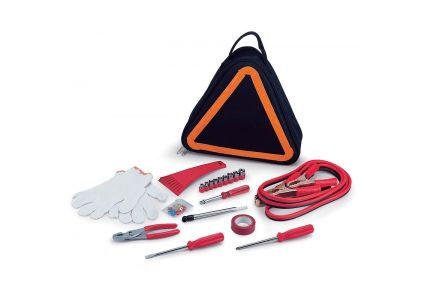Brake, Look and Listen
How do you know when your brakes need work? These symptoms may tell you.
- Brake pad wear. On many vehicles, you can inspect your brake pads by bending down and looking through the spaces in the wheel rims. If the outer pad (the piece pressing against the metal rotor) is less than ¼-inch thick, the pads need to be replaced. The longer you put it off, the more you risk causing expensive damage to other parts of the brake system.
- Squealing, screeching, scraping or grinding noises. When your brake pads get thin, a metal wear indicator on the pad emits a high-pitched squeal that lets you know it's time to have your brakes checked (before any damage is done). But if you hear the grinding or scraping sound of metal-on-metal, it could mean you've waited too long and you're damaging the rotors every time you brake. Get to a service station as soon as possible.
- Decreased stopping power. If the brakes are "mushy" or feel like they're sinking to the floor when you press on the pedal, you might have a leak in the air hose or brake fluid line.
- The car vibrates or pulls to one side when braking. While these symptoms have a variety of possible causes, they could indicate warped rotors, uneven wear on the brake pads or other brake-related problems that need to be addressed by a trained mechanic.
What to Keep in Your Car
Most cars come with a spare tire, tire jack, lug wrench and set of screwdrivers to fix a flat tire. To be prepared for unforeseen mechanical failures or other emergencies that could leave you stranded, keep these items handy in your car:
- Your vehicle manual.
- Proof of auto insurance.
- Emergency contact numbers, such as your roadside assistance service.
- Disposable camera to photograph accident damages for insurance purposes.
- Car phone charger.
- Pair of jumper cables.
- Tool kit with two pairs of locking pliers for wrestling with stubborn nuts and holding hot items, a wrench and screwdrivers (Phillips and flat-bladed).
- First-aid kit with adhesive bandages, gauze pads and bandages, germicidal hand wipes, antibacterial ointment, scissors and tweezers. You can purchase a prepacked kit at a drugstore or grocery store.
- Gas can.
- Flashlight.
- Road flares.
- Bungee cords or rope to tie down any loose objects or car parts.
- Strong, quick-setting, all-purpose epoxy glue to repair a broken distributor cap, window crank or any other plastic item. Duct tape.
- Tire inflator.
- In the winter, a blanket, warm hat and gloves, windshield ice scraper, shovel and traction material.
- Nonperishable food and water, depending on the length of your drive.
Monthly Reminder: Refill Windshield Wiper Fluid
Check your wiper fluid level periodically, and refill the reservoir when necessary. The wiper fluid reservoir is usually clearly visible under the hood and marked with a windshield-wiper icon. Be sure to use specially formulated wiper fluid, which cleans better than water and won't freeze in cold weather.










